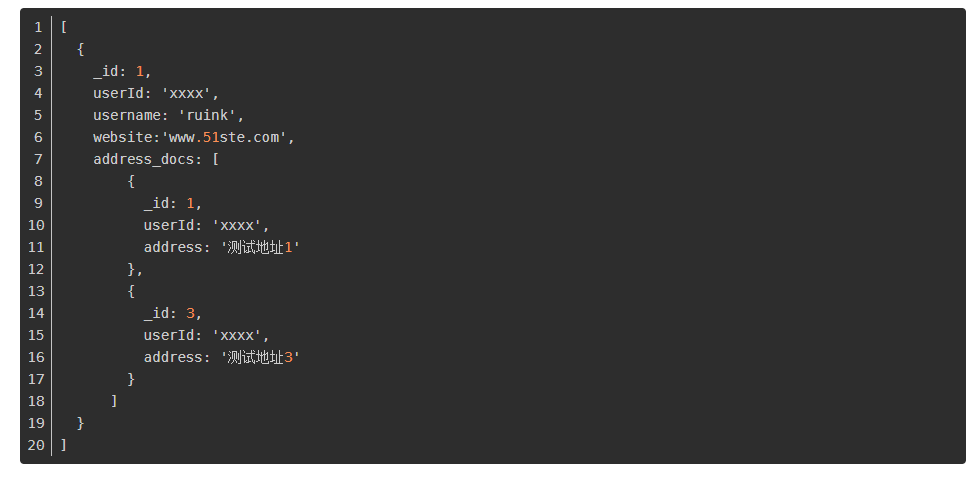mangodb查询语句
1、查询所有记录
db.userInfo.find();
相当于:
select* from userInfo;
默认每页显示20条记录,当显示不下的情况下,可以用it迭代命令查询下一页数据。注意:键入it命令不能带“;”
但是你可以设置每页显示数据的大小,用DBQuery.shellBatchSize= 50;这样每页就显示50条记录了。
2、查询去掉后的当前聚集集合中的某列的重复数据
db.userInfo.distinct("name");
会过滤掉 name 中的相同数据
相当于:
select distict name from userInfo;
3、查询 age = 22 的记录
db.userInfo.find({"age": 22});
相当于:
select * from userInfo where age = 22;
4、查询 age > 22 的记录
db.userInfo.find({age: {$gt: 22}});
相当于:
select * from userInfo where age > 22;
5、查询 age < 22 的记录
db.userInfo.find({age: {$lt: 22}});
相当于:
select * from userInfo where age < 22;
6、查询 age >= 25 的记录
db.userInfo.find({age: {$gte: 25}});
相当于:
select * from userInfo where age >= 25;
7、查询 age <= 25 的记录
db.userInfo.find({age: {$lte: 25}});
相当于:
select * from userInfo where age <= 25;
8、查询 age >= 23 并且 age <= 25 注意书写格式
db.userInfo.find({age: {$gte: 23, $lte: 25}});
相当于:
select * from userInfo where age>=23 and age <= 25;
9、查询 age != 25 的记录
db.userInfo.find({age: {$ne: 25}});
相当于:
select * from userInfo where age != 25;
10、查询 name 中包含 mongo 的数据 模糊查询用于搜索
db.userInfo.find({name: /mongo/});
相当于:
select * from userInfo where name like '%mongo%';
11、查询 name 中以 mongo 开头的
db.userInfo.find({name: /^mongo/});
相当于:
select * from userInfo where name like 'mongo%';
12、查询 name 中以 mongo 结尾的
db.userInfo.find({name: /mongo$/});
相当于:
select * from userInfo where name like ‘%mongo’;
模糊查询语法:{ : /pattern/ }
其中options值可以为:
i -- 不区分大小写。
m -- 匹配value中有换行符(\n)的情形,还有一个情形是:匹配规则中使用了锚,所谓的锚就是^ 开头, $ 结尾。
s -- 允许点字符(.)匹配所有的字符,包括换行符。
x -- 忽视所有空白字符。
13、查询指定列 name、age 数据
db.userInfo.find({}, {name: 1, age: 1});
相当于:
select name, age from userInfo;
当然 name 也可以用 true 或 false,当用 ture 的情况下和 name:1 效果一样,如果用 false 就是排除 name,显示 name 以外的列信息。
14、查询指定列 name、age 数据, age > 25
db.userInfo.find({age: {$gt: 25}}, {name: 1, age: 1});
相当于:
select name, age from userInfo where age > 25;
15、按照年龄排序 1 升序 -1 降序
升序:
db.userInfo.find().sort({age: 1});
相当于:
select * from userInfo order by age asc;
降序:
db.userInfo.find().sort({age: -1});
相当于:
select * from userInfo order by age desc;
17、查询前 5 条数据
db.userInfo.find().limit(5);
相当于:
select * from userInfo limit 5;
18、查询 10 条以后的数据
db.userInfo.find().skip(10);
19、查询在 6-10条 之间的数据
db.userInfo.find().limit(10).skip(5);
可用于分页,limit 是 pageSize,第n页时 skip 是 (n-1)*pageSize
相当于:
select * from userInfo limit 5,5;
20、and 查询 name = zhangsan, age = 22 的数据
db.userInfo.find({name: 'zhangsan', age: 22});
相当于:
select * from userInfo where name = 'zhangsan' and age = 22;
21、or 查询
db.userInfo.find({$or: [{age: 22}, {age: 25}]});
相当于:
select * from userInfo where age = 22 or age = 25;
注意多条件间用中括号[]包围。
22、in 查询
db.userInfo.find({age :{$in:[22,25]}});
相当于:
select * from userInfo where age in (22,25);
23、查询某个结果集的记录条数 统计数量
db.userInfo.find({age: {$gte: 25}}).count();
相当于:
select count(*) from userInfo where age >= 20;
skip(), limilt(), sort()三个放在一起执行的时候,执行的顺序是先 sort(), 然后是 skip(),最后是显示的 limit()。
24、查询某个时间段的数据(时间为日期类型,非字符串类型)
db.userInfo.find({createTime:{$gt:ISODate("2020-11-09T00:00:00Z")}});
相当于:
select * from userInfo where createTime> '2020-11-09 00:00:00';
25、对表中一字段进行统计求和
db.userInfo.aggregate({$group:{_id:null,score:{$sum:"$score"}}})
相当于:
SELECT SUM(score) from userInfo;
26、对表中一字段进行统计求平均值
db.userInfo.aggregate({$group:{_id:null,score:{$avg:"$score"}}})
相当于:
SELECT AVG(score) from userInfo;
27、对表中指定条件记录中的某字段求和
db.userInfo.aggregate({$match:{createTime:{$gte:ISODate("2020-11-10T00:00:00Z"),$lt:ISODate("2020-11-11T00:00:00Z")}}},{$group:{_id:null,score:{$sum:"$score"}}})
相当于:
SELECT SUM(score) from userInfo where createTime >= '2020-11-10 00:00:00' and createTime < '2020-11-11 00:00:00';
28、根据A表,匹配B表所有满足条件的集合,如根据用户表userInfo表中的userId字段找出userAdress表中所有地址的集合,其中userId也为userAdress中的字段。
假设 有 用户集合, 存储的测试数据 如下:
db.userInfo.insert([
{ "_id" : 1, "userId" : "xxxx", "username" : "ruink", "website" : "www.51ste.com" },
{ "_id" : 2, "userId" : "yyyy", "username" : "foosingy", "website" : "www.scgossip.com" }
])
假设 有 地址集合, 存储的测试数据 如下:
db.userAdress.insert([
{ "_id" : 1, "userId" : "xxxx", address: "测试地址1"},
{ "_id" : 2, "userId" : "yyyy", address: "测试地址2"},
{ "_id" : 3, "userId" : "xxxx", address: "测试地址3"},
])
查询语句:

上表为找出userId="xxxx"的所有地址的集合,查询结果如下:
复制

注意:
字段是什么类型,那么查询时字段值的类型就应该是什么类型,比如如果字段类型是 NumberLog,那么查询时就应该执行查询类型为 NumberLog,如

转自:https://blog.csdn.net/qq_41767116/article/details/125586683
最新文章
- java Future 接口介绍
- apache如何解决跨域资源访问
- JavaScript call
- PetaPoco4.0 实体某个字段不赋值会更新成null解决方案
- 【腾讯GAD暑期训练营游戏程序班】游戏中的特效系统作业说明文档
- load、init和initialize的区别
- PyMongo下载及安装
- Error: Could not access the Package Manager. Is the system running?
- Camera拍照声设定
- Eclipse对printf()不能输出到控制台的解决方法
- 替代 yunio , 推荐一个国外的云存储(同步盘) wuala(这个网站也挂了)——功能评测非常全面
- contentWindow,
- cuda学习3-共享内存和同步
- 《Python编程从入门到实践》_第四章_操作列表
- 联发科Helio P90(mt6779),P70(mt6775),P60(MT6771),P35,P22(MT6762)芯片参数规格
- loj#6436. 「PKUSC2018」神仙的游戏(生成函数)
- HashMap和Hashtable的同和不同(详细比较)
- Linux搭建SVN环境
- UI简述
- Android ormlite like() function is not working